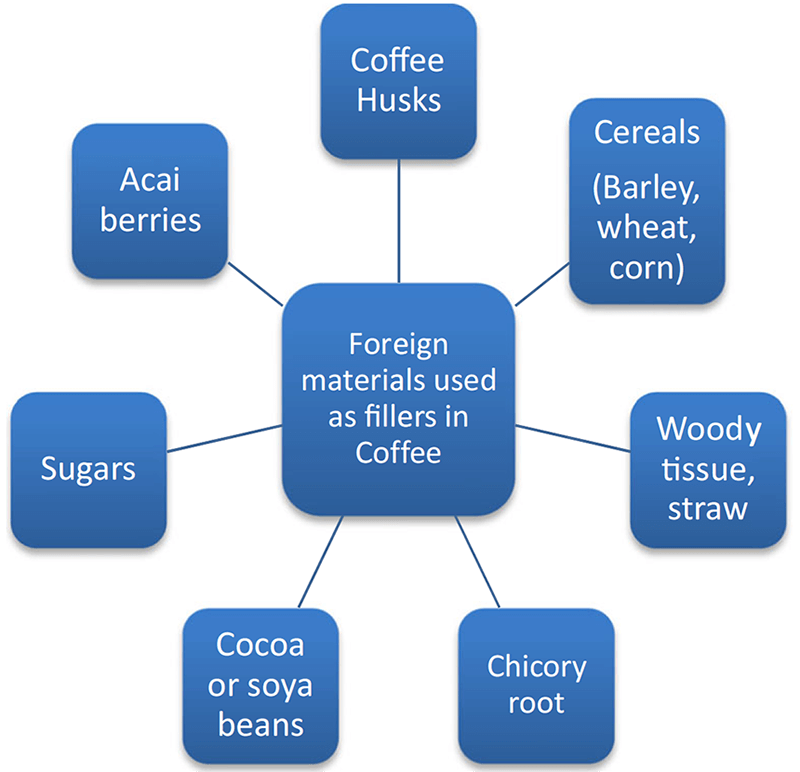
Coffee has gained increasing popularity worldwide for its refreshing, stimulating taste, and health benefits. However, adulteration is becoming a problem for the coffee market. Coffee adulteration involves the addition of low-cost foreign materials, as well as mixture of low-quality beans or beans from different geographical and/or botanical regions. In order to protect the rights of customers, it is important to develop reliable methods to detect adulteration of coffee products.
Lifeasible, as a worldwide leader in food testing, provides state-of-the-art technologies to help you identify coffee adulterants
The most commonly used adulterants include coffee husks and stems, chicory, cereal grains (e.g., corn, barley, wheat middlings, rye, triticale, etc.), woody tissue, cocoa or soya beans, acai berries, and/or exogenous sugars (Figure 1).
 Figure 1. Examples of foreign materials used as fillers in coffee (Burns et al., 2017)
Figure 1. Examples of foreign materials used as fillers in coffee (Burns et al., 2017)
Constitution of metabolites, such as oligosaccharides, volatile components, and fatty acids (FAs), can be used as markers to analyze the presence of foreign materials. For example, a high content of glucose indicates the addition of wheat; and high contents of fructose, raffinose, and stachyose may indicate soybean adulteration. Besides, high levels of total xylose and mannitol are indicative of the presence of coffee husks. Elevated levels of maltose and total glucose indicate the addition of maltodextrins. Moreover, high levels of sucrose and total glucose reflect the addition of caramelized sugar. The concentrations of maltose, g-tocopherol, furfural, 5-methylfurfural, and the ratio of linoleic and stearic acid are higher in maize addition samples than in pure coffee samples. In addition, 2-methylbutanal, 3-methylbutanal, and furan are the most prevalent compounds in barley addition products. Butyrolactone and hexanoic acid are commonly observed only in raw and roasted defective beans, respectively.
The content of the above metabolites can be quantified by various methods. At Lifeasible, we are capable of performing many chromatography methods including high-performance liquid chromatography (HPLC) with different types of separation (normal phase, reverse, and ion exchange) and detection (absorption in ultraviolet and visible region-UV/Vis, fluorescence, pulsed amperometric detector-PAD, and refractive index-RI) methods, gas chromatography (GC) with a capillary column and flame ionization detector (FID), thermionic detector (TID), or mass spectrometry (MS); ultra-high-performance liquid chromatography high resolution mass spectrometry (UPLC-HRMS), solid phase microextraction gas chromatography mass spectrometry (SPME-GC/MS), etc.. We can also perform multiple spectroscopy techniques (e.g., near-infrared (NIR) spectroscopy, diffuse reflectance infrared Fourier transform spectroscopy (DRIFTS), Raman spectroscopy, and nuclear magnetic resonance (NMR) spectroscopy), multispectral imaging techniques, capillary electrophoresis, and so on.
Because of its superior taste, Arabica coffee beans cost twice as that of Robusta coffee beans. However, as the Robusta plants are easier to grow and have higher yields, it is common to adulterate of Arabica with the cheaper Robusta beans. In order to detect this type of adulteration, kahweol and 16-O-methylcafestol, predominant compounds in Robusta coffee, can be used as markers. We provide multiple methods for quantification of kahweol and 16-O-methylcafestol, including NMR spectroscopy, Fourier transform ion cyclotron resonance mass spectrometer (FT-ICR-MS), ultraviolet (UV)-visible spectrometry, HPLC, high-resolution-magic-angle spinning (HR-MAS), and so on. Furthermore, DNA molecular markers such as microsatellites can also be employed to identify different species or varieties of coffee.
The flavor and taste of coffee are the most important characters for evaluating its quality. These characters are primarily determined by environmental factors such as soil and climate. Thus, it is critical to properly label the geographic origin of coffee beans. Experts at Lifeasible can provide advanced techniques (e.g., FTIR, 1H NMR, LC-MS, GC-FID, etc.) and multivariate statistical analysis to classify geographical origins of coffee products.
Additionally, we offer microscopy techniques (e.g., optical and electron microscopy) and physicochemical analyses (e.g., moisture content, mineral residues, ether-extractable substances, and caffeine) for detection of adulteration in coffee products.
With a full array of analytical methods and an excellent team of experts in food science, Lifeasible will help you detect coffee authentication with high sensitivity and reliability. Welcome to contact us for further information.
Reference
1. Burns, D.T.; et al. Ground roast coffee: Review of analytical strategies to estimate geographic origin, species authenticity and adulteration by dilution[J]. Food analytical methods. 2017, 10(7): 2302-2310.
Lifeasible has established a one-stop service platform for plants. In addition to obtaining customized solutions for plant genetic engineering, customers can also conduct follow-up analysis and research on plants through our analysis platform. The analytical services we provide include but are not limited to the following:
Get Latest Lifeasible News and Updates Directly to Your Inbox
Adaptive Evolutionary Mechanism of Plants
February 28, 2025
Unraveling Cotton Development: Insights from Multi-Omics Studies
February 27, 2025